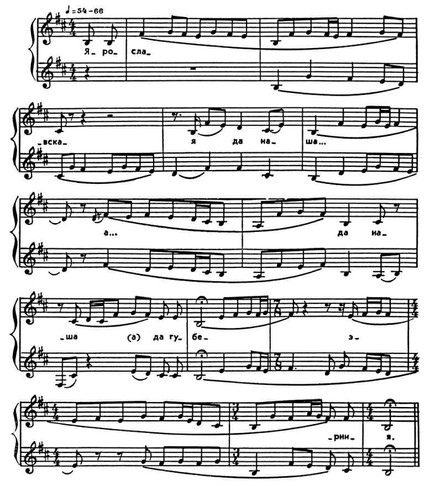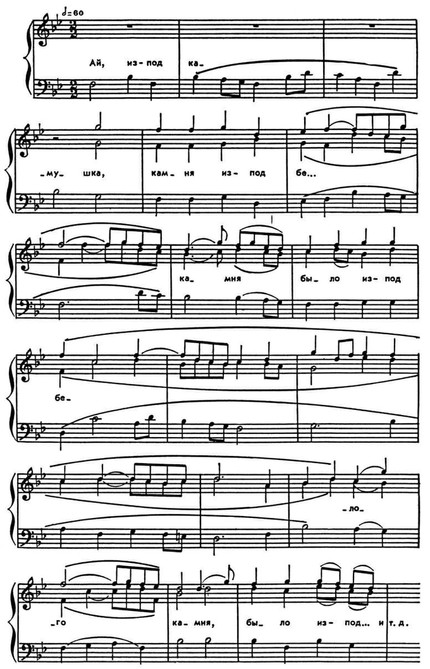
Undertone |
A term denoting various melodic lines (voices) in Russian polyphonic (choral and ensemble) performances of songs, primarily lyrical ones. It is used in Nar. chanter practice, entered the music. folklore. A derivative of it is the more general term “vocal polyphony”. P. is associated with the word “voice” in the meaning of singing along to someone on high notes (in such cases they also say “squeal”) osn. melody or its variation (the art of the bellows). Other people are also known. terms of the same meaning: “eyeliner” (in the southern Russian region, in Ukrainian and Belarusian Polesie), “dishkant” (on the Don), “pull on a piston” (Belgorod region), “goryak” (in Ukraine). The latter terms are applied only to the upper P., forming a relatively independent. melodic party; the lower voices in these cases “bass” (Belgorod region), “bass” (Ryazan region), etc. The term “overvoice” is not used – both upper and lower choirs. the voices are equally called P. The upper P. is usually entrusted to one voice, while there may be several lower ones. T. n. main the melody is most often conducted in a middle voice; often it is performed by a singer (on the Don – bass), although the functions of the voices throughout the song in some styles can change (for example, the main melody can occasionally move from voice to voice). In all cases, P. are called voices that deviate from the main one up or down. This is a characteristic national a feature of folklore polyphony as an act of “collective discovery of music” (B. V. Asafiev). The item or supports osn. melody (most often from below), either sets it off, ornaments it (from above), or opposes it, forms a temporary contrast.
In Russian In the north, the monophonic basis of a song is sung in unison or in an octave, while P., avoiding uniform parallel movement, vary the same tune, as if decorating it, at times opposing it with relative independence. singing (usually from above), fill in the pauses and jumps of the main. voices often merge with him in unison or an octave, thereby more clearly revealing his leading turns. The unison-octave completion of the song on the final fret-rhythm is always obligatory. stable. P. – “a sprout on the main tune, sometimes more, sometimes less clearly branching off from the main trunk” (Asafiev). Sometimes P. in independence and expressiveness is equated with the so-called. main chant, and it can be difficult to distinguish between them. In northern Russian. Styles are dominated by P. – offshoots from the main. voices (in essence, its close variants):

From the collection of E. V. Gippius and Z. V. Ewald “Songs of Pinezhya”, No 55.

From the collection of A. M. Listopadov “Songs of the Don Cossacks”, vol. 3, No. 19.
In the middle and especially southern Russian. P.’s styles are often more freely counterpointed with DOS. voice (see example above).
Some echoes simplify, “straighten” the main. melody, others, on the contrary, ornament it, develop it and enrich it. Special types of P. are the pedal (ch. arr. in short sections of the song) and the so-called. non-textual P. – “vocalises” (for example, in the Voronezh region), with frequent stops at the extended sound of the tonic (lower or upper) and, less often, fifths or the VII natural degree (in the case of a temporary deviation).
In Belarusian. Polissya chorus is divided into two independent. parties: main the melody sounds in a lower, “bass” voice (due to the melodic conciseness, Z. V. Ewald defined it as a kind of cantus firmus), which in the process of polygoal. the chant can branch out polyphonically, while the top solo voice (“padvodchyk”) leads the liner. One and the same tune often underlies several. different in character and melodic. development of the lyric. polygonal songs (for example, in the Polissya village of Tonezh).
During one song, a gradual complication of the chorus is possible. textures, activation of P. On the whole, the complex, dynamic “mechanics” of the real interaction of voices in a genuine Nar. chorus has not yet been fully explored. The latest multi-channel sound recording and other technical. means can contribute to the discovery of the true place and meaning of P. in Nar. choir. singing dec. regional styles.
References: Melgunov Yu., Russian songs recorded directly from the voices of the people, vol. 1, M., 1879; Palchikov N., Peasant songs recorded in the village of Nikolaevka, Menzelinsky district, Ufa province, M., 1888; Lopatin H. M., Prokunin V. P., Collection of Russian folk lyrical songs, parts 1-2, M., 1889; Lineva E., Great Russian songs in folk harmonization, vol. 1, St. Petersburg, 1904; Gippius E., On Russian folk polyphony in the late 1948th – early 2th centuries, “Soviet Ethnography”, 1960, No. 1974; Rudneva A., Russian folk choir and work with him, M., 1961, the same, 1; Bershadskaya T., The main compositional patterns of the polyphony of the Russian folk peasant song, L., 1962; Popova T., Russian folk musical creativity, vol. 1965, M., 1971; Asafiev B., Speech intonation, M.-L., 1972; Mozheiko Z., Song culture of Belarusian Polissya. Tonezh village, Minsk, XNUMX; Samples of folk polyphony, comp., total. ed. and foreword by I. Zemtsovsky, L.-M., XNUMX.
I. I. Zemtsovsky




